Italy beat USA to take over the top position in the S50; Germany Lasker Schachstiftung GK is unstoppable in the S65 section.
The seventh round brought some unexpected results in the S50 section and very expected results in the S65 section.
Italy scored a very convincing victory over USA. As the match went on, the American team didn’t even stand a chance.
On board one, David (2523) demonstrated his attacking prowess and demolished Shabalov (2465) in mere 29 moves.

Black’s position was already bad, but his last move 21…h6, only provoked the crashing 22.Nxf7! Qx75 23.Qg4 Kg7 24.f5! and the curtain fell just five moves down the road – 1-0.
On board three, Ortega (2410) choked off Novikov (2513) in a hedgehog where, at first sight, it appeared that Black was quite alright, in view of White’s atypical placement of the pieces. It turned out however that it was a very effective setup.
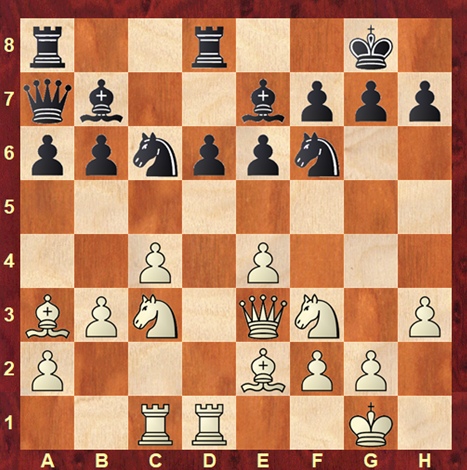
After 16.e5! dxe5 17.Bxe7 Nxe7 18.Nxe5 White’s initiative became too strong to contain, and Ortega didn’t allow his opponent even a single chance, winning in 36 moves.
On the boards where USA was playing with the white pieces, Ehlvest (2530) couldn’t do much against Godena’s (2429) Queen’s Gambit Accepted and Yermolinsky’s (2419) misplacement of the rooks in the middlegame in the Catalan meant that he was the one fighting for equality against Bellia (2388).
An impressive and dominating match for the Italian team that stepped up when it mattered most. With this victory, Italy took over the lead from USA and how sits alone at the top of the standings with 12 points.
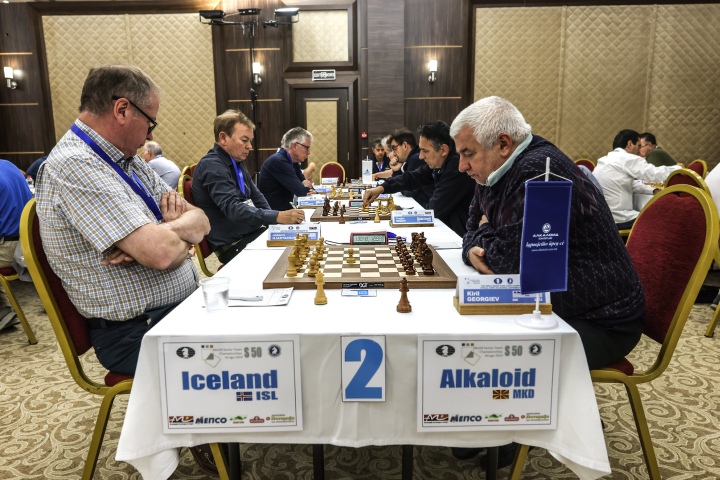
In the match between Iceland and North Macedonia Alkaloid, the first victory was scored on board three, where, in a very sharp position Bogdanovski (2385) blundered against Arnason (2419).
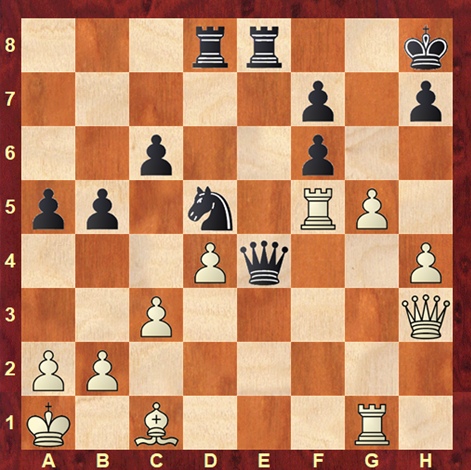
White doesn’t really threaten much on the kingside, so Black had a chance to start his own play on the queenside with either 29…b4 or 29…Qc2. Instead, he played a defensive move 29…Rd6? which allowed White to push 30.h5, creating a real threat g5-g6. In time trouble, Black went for what looked like a simplifying sequence, missing that after 30…fxg5 31.Rfxg5 Ne3? 32.Bxe3 Qxe3 33.Qxe3

He cannot recapture on e3 in view of the mate on g8. 1-0
A balanced draw on board four between Stanojoski (2351) and Thorallsson (2382) followed before Nedev (2465) equalised the score with a win over Petursson (2396). The game was one-sided, as Black couldn’t recover from the bad opening choice he made early on.

In this well-known Najdorf position arising from the line with 6.h3, Black went for the very dubious 8…d5? which led to a bad endgame after 9.fxe5 Nxe4 10.Nxe4 dxe4 11.Qxd8 Kxd8 12.Bf4.

Black had problems with the pawn on e4, and while he tried to defend it with tactical means, eventually, White emerged with an extra pawn, which he converted without much trouble.
With the match tied, everything depended on the result on board one. Hjartarson (2432) and Georgiev (2542) reminded us of the famous Karpov-Kasparov duels in the Classical Scheveningen. The position remained balanced for a very long time, but it was notable that Hjartarson avoided possible repetitions and kept the game going.
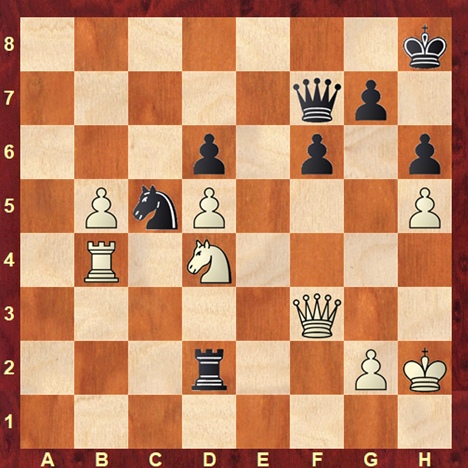
Black should have just bided his time with 57…Qe7, for example, but he lunged forward with 57…f5? Most likely, this decision was based on miscalculation, as White could have taken the pawn on f5, either with knight or queen, which would have given him a winning advantage.
However, it appears that both players were under the impression that the pawn shouldn’t be taken. The game went 58.b6 (also good) Qf6 59.Nc6? (instead of the winning capture on f5).
Now Black should have played 59…Qg5, but he probably missed the drawing combination:

After 59…Qg5! 60.b7 Nxb7 61.Rxb7 Rxg2! 62.Qxg2 Qh4 leads to a perpetual check.
Georgiev chose 59…Qf7?! which resulted in White’s winning a piece after 60.Nd8 Qxd5 61.Qxd5 Rxd5 62.b7, but the ensuing endgame should still be a draw.

White managed to win Black’s d-pawn, though it shouldn’t have sufficed. Play continued for a very long time, and the critical moment arose on move 101.
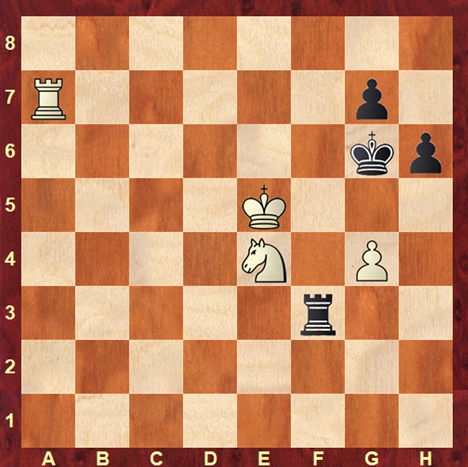
White created the threat of bringing the knight to f5. Black had only one way to stop that – 101…Rb3! with the idea to pin the knight after 102.Kf4 Rb4!. Georgiev either missed White’s idea or his best defence and played 101…Re3? and after 102.Kf4 Rb3 103.Ng3, the knight was coming to f5. The game finished with a neat two-move combination.
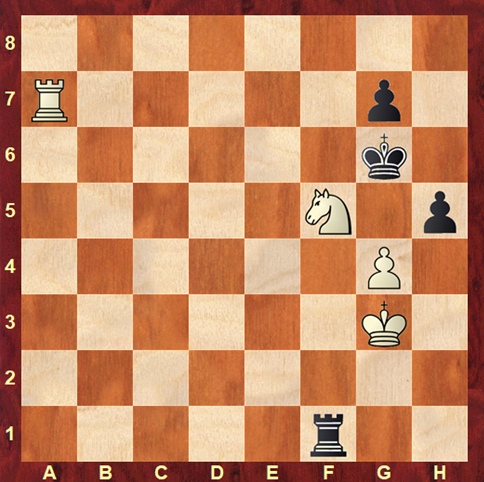
109.Rxg7+ Kf6 110.g5+! Black resigned in view of 110…Kxf5 111.Rf7 when the rook on f1 is lost. 1-0
A dramatic win for Iceland, who are now sharing second place with USA, one point behind the leaders, whom they face in the penultimate round.
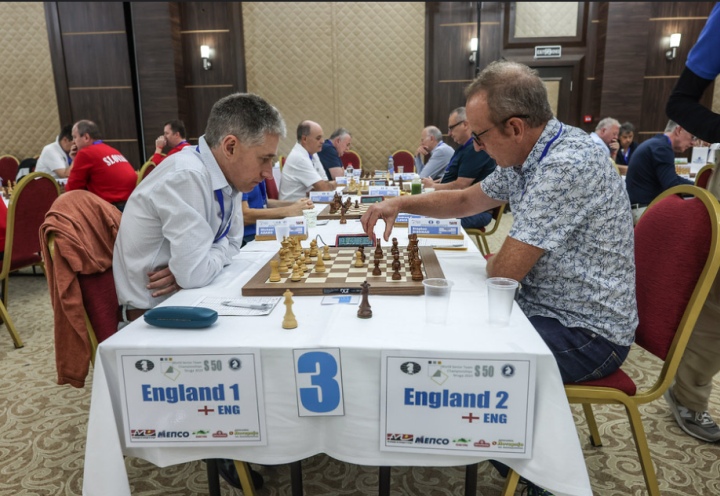
In the duel of the two English teams, England 1 beat England 2 by 3-1.
Adams (2662) outplayed Dishman (2304) on board one, the game ending in a pretty checkmate.

White wrapped up the game with 37.Nc5 Rb4 38.Bf8 mate 1-0.
What happened on board two was some sort of a mystery.
After both players followed theory until move 13, Lewis (2238) chose the rare and not-very-good 13.Nf3?! instead of the theoretical 13.Qa3. After Flear (2405) replied with the natural 13…c5, White had a hallucination.

Lewis played 14.Ng5?!? and after the simple 14…Qxg2, with a double attack on the rook on h1 and the knight on g5, the game was practically over. White resigned six moves later.
The other two games Arkell (2352) – Clark (2278) and Stebbings (2257) – Davies (2354) were drawn without much hassle.
This win allowed England 1 to stay in contention for the medals. Since they have already played all the strong teams, they can now expect weaker opponents in the last two rounds.
In the S65 section, the usual suspects kept on winning.
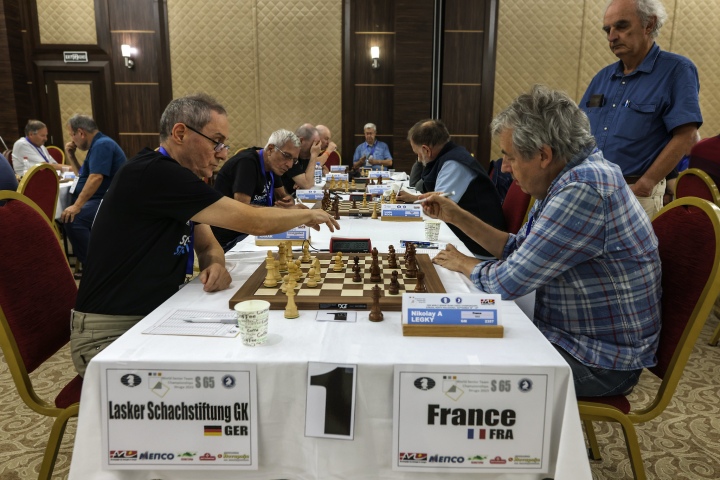
Germany Lasker Schachstiftung GK beat France 3-1 thanks to wins with the white pieces on boards one and three.
The finale on board one was notable.
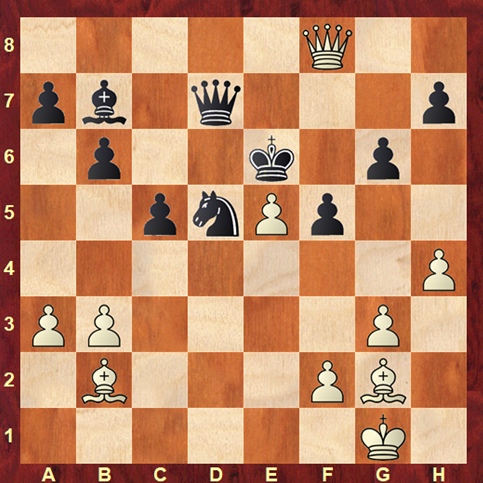
Knaak (2438) was winning for some time, but there was no real need for Legky (2357) to blunder into a mate in one (!) with 34…Qf7?? 35.Qd6 mate.
On board three, Kalintschew (2377) crowned his positional domination against Boudre (2245) with an effective exchange sacrifice.

White demolished Black’s position with 40.Rc6! Bxc6 41.Rxc6 Kd7 42.Nxd5. With the c7-pawn also falling, Black resigned. 1-0
The draws on boards two and four only cemented Germany’s win. Meister (2439) was a pawn up against Roos (2253) in a position with opposite-coloured bishops, while Giffard (2155) and Koehler (2189) displayed mutual respect and drew in 27 moves.
England 1 kept the pace by beating Israel with the same score 3-1.

The first game to finish was on board one, where in the sharp Najdorf variation with 6.Bg5, it seemed that Nunn (2569) mixed up things and ended up in an inferior version of the main line. Luckily for him and the team, his timely draw offer was accepted by Gruenfeld (2388).
Board four saw a quick draw between Afek (2215) and Baker (2222).
The wins for England came on boards two and three.
First, it was Chapman (2248) who converted his superior opening against Kagan (2244), though Black’s decision on move 28 is difficult to explain.

Black is lost, but by staying put, he could have resisted for longer. Instead, he just gave up a pawn with 28…Ng4? 29.hxg4 hxg4 30.Bxg4 fxg4 31.Qxg4. Now, he was lost and a pawn down. Kagan resigned one move later.
On board two Birnboim’s (2346) speculative attack didn’t work against Kosten’s (2352) solid Nimzo-Indian position. All that the latter needed to do was to escape with the king from c8 to g8, which he did and preserved his extra rook.
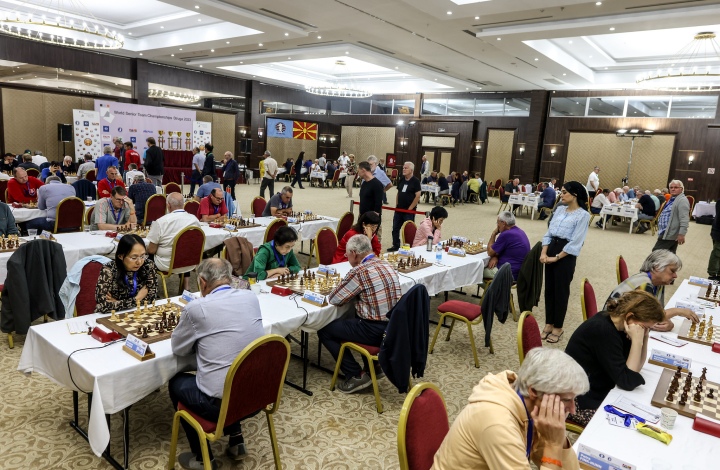
The first two places seem decided in the S65 section, with Germany on 14 and England on 12, full two points ahead of third-placed Slovakia on 10, with all these teams having played each other.
In the S50 section, everything is up for grabs. The last two rounds won’t get any easier.
Written by GM Alex Colovic
Photos: Mark Livshitz
Official website: seniorteam2023.fide.com/

